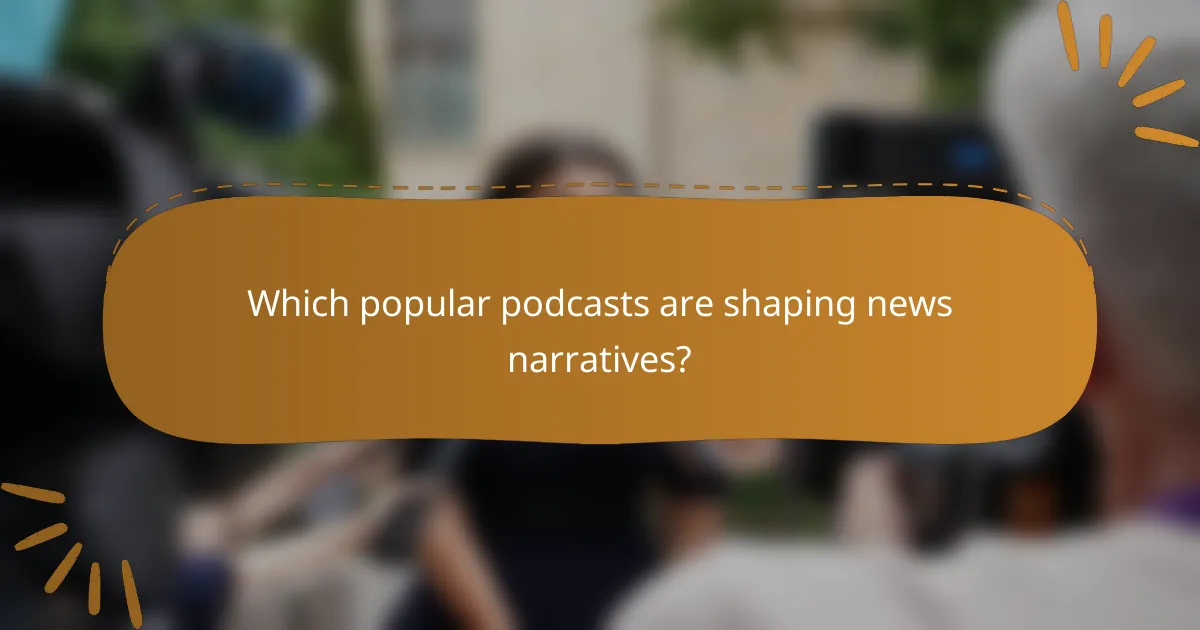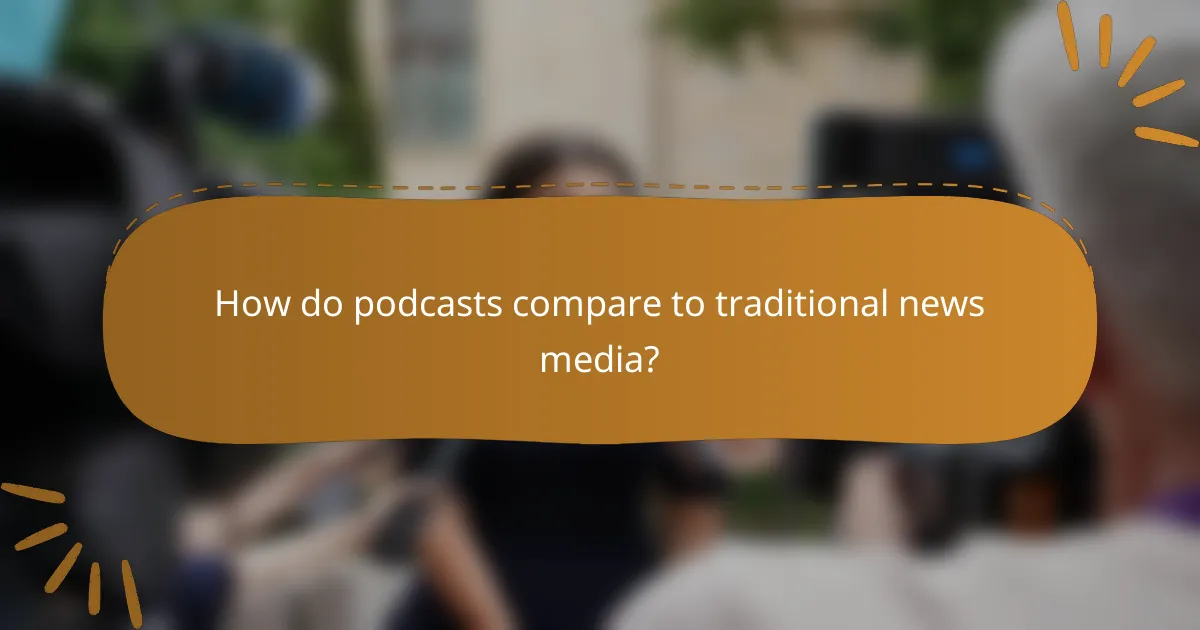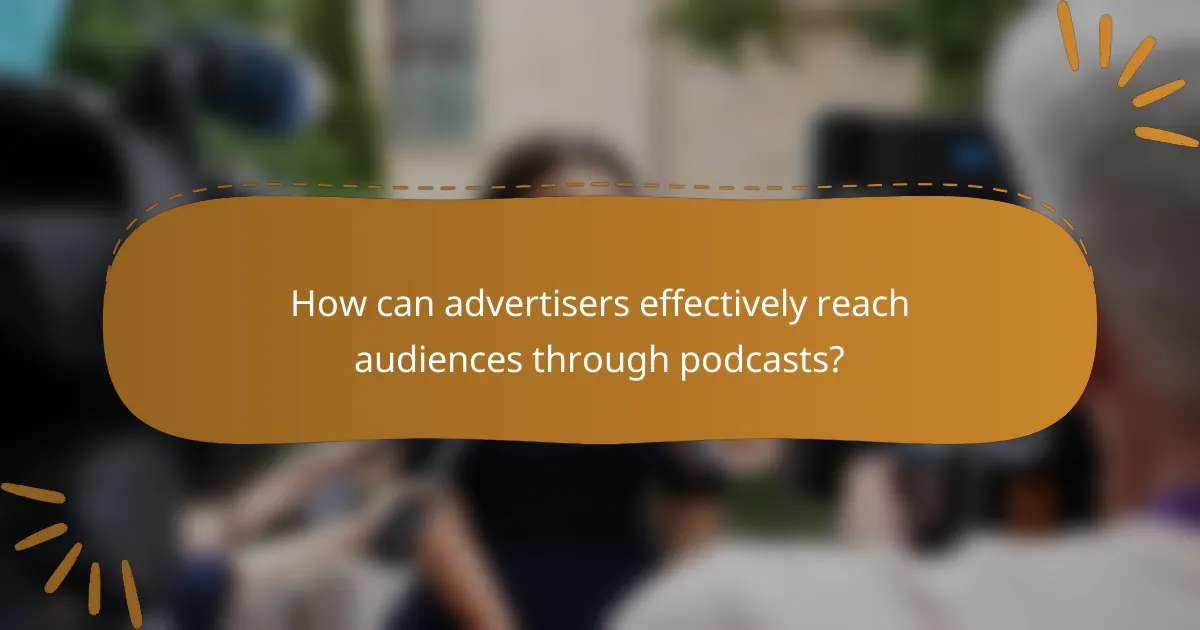Podcasts are revolutionizing news consumption by providing a flexible and engaging format that fits seamlessly into modern lifestyles. With the ability to listen on-the-go, they enhance accessibility and allow for deeper engagement with current events. Influential podcasts are not only delivering news but also shaping narratives through in-depth analysis and diverse perspectives, making complex topics more relatable for audiences.

How are podcasts changing news consumption in the United States?
Podcasts are significantly transforming how news is consumed in the United States by offering a more flexible and engaging format. They allow listeners to access news content in a way that fits their schedules, leading to increased engagement and a broader audience reach.
Increased accessibility
Podcasts enhance accessibility by providing news content that can be consumed anywhere and anytime. With smartphones and various podcast platforms, users can easily listen to news while commuting, exercising, or performing daily tasks.
This convenience has led to a rise in podcast listenership, with millions of Americans tuning in regularly. The ability to access news on-the-go has made it easier for diverse demographics to stay informed.
On-demand content availability
The on-demand nature of podcasts allows listeners to choose when and what news they want to consume. Unlike traditional news broadcasts, which are scheduled, podcasts can be accessed at any time, enabling users to catch up on the latest stories at their convenience.
This flexibility caters to busy lifestyles and offers a way for people to engage with news topics that interest them most, whether it’s politics, technology, or culture.
Diverse perspectives
Podcasts often feature a wide range of voices and viewpoints, providing listeners with diverse perspectives on news stories. This variety helps to challenge mainstream narratives and encourages critical thinking among audiences.
By highlighting underrepresented voices and niche topics, podcasts contribute to a more comprehensive understanding of current events, fostering a richer dialogue around important issues in society.

What are the benefits of using podcasts for news?
Podcasts offer several advantages for news consumption, including flexibility, accessibility, and an engaging format. They allow listeners to stay informed while managing other tasks, making news more integrated into daily life.
Convenience for multitasking
Podcasts are ideal for multitaskers, as they can be listened to while driving, exercising, or doing household chores. This flexibility allows individuals to consume news without dedicating specific time solely for reading or watching news broadcasts.
Many people find that they can easily fit in a podcast episode during their commute or workout, making it a practical choice for busy lifestyles. This convenience helps ensure that news consumption becomes a seamless part of everyday activities.
Engagement through storytelling
Podcasts often utilize storytelling techniques to present news in a compelling manner, which can enhance listener engagement. By weaving narratives around current events, podcasts can make complex topics more relatable and easier to understand.
This storytelling approach not only captures attention but also fosters a deeper emotional connection to the news. Listeners may find themselves more invested in the stories being told, leading to a greater retention of information.
Personalized listening experiences
Podcasts provide a personalized experience, allowing listeners to choose topics that interest them most. With a vast array of news podcasts available, individuals can curate their listening habits to match their preferences, whether they prefer politics, technology, or culture.
This level of customization means that listeners can engage with news that resonates with them, making the experience more enjoyable and relevant. Additionally, many platforms offer recommendations based on listening history, further enhancing the personalized aspect of news consumption.

Which popular podcasts are shaping news narratives?
Several influential podcasts are significantly shaping news narratives today, providing listeners with in-depth analysis and diverse perspectives. These shows often blend storytelling with current events, making complex topics more accessible and engaging for audiences.
The Daily by The New York Times
The Daily is a flagship podcast from The New York Times that delivers a deep dive into one major news story each weekday. Hosted by Michael Barbaro, it features interviews with Times journalists and experts, offering listeners a comprehensive understanding of the news behind the headlines.
This podcast is particularly effective for those seeking a concise yet thorough exploration of current events, typically lasting around 20 to 30 minutes. Its storytelling approach helps listeners grasp the nuances of complex issues, making it a staple for news consumers.
Pod Save America
Pod Save America is a political commentary podcast hosted by former Obama staffers Jon Favreau, Jon Lovett, Dan Pfeiffer, and Tommy Vietor. It combines news analysis with humor, focusing on American politics and the impact of current events on everyday life.
Listeners appreciate its engaging format, which often includes interviews with political figures and activists. The show encourages civic engagement and provides actionable insights, making it popular among those looking to stay informed about political developments.
Up First by NPR
Up First is NPR’s daily news podcast that delivers the day’s top stories in a quick, digestible format. Each episode runs about 10 to 15 minutes, making it ideal for listeners who want a brief overview of the news before starting their day.
This podcast is known for its straightforward reporting and ability to cover a range of topics, from international affairs to local news. It serves as an excellent starting point for anyone looking to stay updated without investing a lot of time.

How do podcasts compare to traditional news media?
Podcasts offer a distinct alternative to traditional news media by providing on-demand audio content that caters to the listener’s schedule. Unlike newspapers or television, which have fixed publishing times, podcasts allow for flexible consumption, making them increasingly popular among diverse audiences.
Flexibility in consumption
Podcasts can be accessed anytime and anywhere, whether during a commute, workout, or while performing household chores. This flexibility contrasts sharply with traditional news media, which often requires viewers to be present at specific times to receive updates.
Listeners can choose episodes that fit their interests and time constraints, allowing for a personalized news experience. This adaptability is a significant factor in the growing popularity of podcasts as a news source.
Different audience demographics
Podcasts attract a wide range of demographics, often appealing to younger audiences who prefer digital content over print or broadcast media. Research indicates that a substantial portion of podcast listeners are between the ages of 18 and 34, highlighting a shift in how news is consumed.
This demographic shift means that news organizations are increasingly tailoring their content to meet the preferences of these younger listeners, focusing on topics that resonate with their interests and values.
Varied content formats
Podcasts offer a variety of content formats, including interviews, narrative storytelling, and roundtable discussions. This diversity allows news organizations to present information in engaging ways that can enhance understanding and retention.
For example, a news podcast might feature an in-depth interview with an expert, providing insights that traditional media might not convey as effectively. This variety not only caters to different preferences but also allows for deeper exploration of complex issues.

What criteria should you consider when choosing news podcasts?
When selecting news podcasts, focus on the credibility of the host, the production quality, and the frequency of updates. These factors significantly influence the reliability and engagement of the content you consume.
Credibility of the host
The host’s credibility is crucial in determining the trustworthiness of a news podcast. Look for hosts with a background in journalism or relevant expertise in the topics they cover. Check their previous work, qualifications, and any affiliations with reputable media organizations.
Additionally, consider the host’s ability to present information objectively. A host who frequently shares personal opinions may introduce bias, which can affect the overall quality of the news presented.
Production quality
High production quality enhances the listening experience and reflects the professionalism of the podcast. Pay attention to audio clarity, editing, and overall sound design. Poor production can distract from the content and make it difficult to follow the discussion.
Look for podcasts that invest in good equipment and skilled editing. A well-produced podcast often indicates that the creators are serious about delivering valuable content to their audience.
Frequency of updates
The frequency of updates is an important factor in staying informed. Regularly updated podcasts can provide timely news and insights, while infrequent releases may lead to outdated information. Aim for podcasts that publish episodes at least weekly to ensure you receive current news coverage.
Consider subscribing to multiple podcasts to diversify your news sources. This approach allows you to stay informed on various topics and perspectives, especially if some podcasts have varying update schedules.

How can advertisers effectively reach audiences through podcasts?
Advertisers can effectively reach audiences through podcasts by leveraging targeted ad placements and understanding listener demographics. This approach allows brands to connect with engaged listeners who are more likely to respond positively to relevant advertisements.
Targeted ad placements
Targeted ad placements involve inserting ads into specific podcast episodes or segments that align with the interests of the audience. By analyzing listener data, advertisers can choose shows that resonate with their target demographics, increasing the likelihood of engagement.
For example, a fitness brand might place ads in health and wellness podcasts, while a technology company could target tech review shows. This strategy not only enhances relevance but also improves the return on investment (ROI) for advertising campaigns.
Advertisers should consider the timing of their ads as well. Mid-roll ads, which play during the podcast, often have higher retention rates compared to pre-roll ads, as listeners are already engaged. Testing different placements and formats can help identify the most effective strategies for reaching specific audiences.
